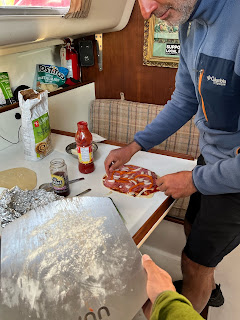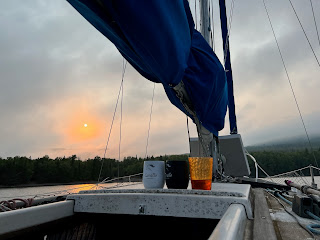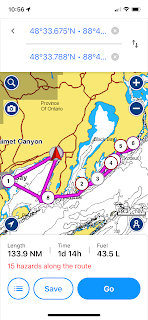
10,000 aircraft are parked on the grass around the runways at Wittman Field and the latest I heard, over 200,000 people converge here for the week to express their love of everything related to flight. Maybe it’s 700,000.
This is the Experimental Aircraft Association (EAA) annual fly-in “Airventure”, a week dedicated to the crazy concept of lifting ourselves off the earth, which is celebrating its 70th anniversary this year.
For about the last 20 years, it’s been an annual pilgrimage for the three generations of us: we drive south from our home north of Lake Superior, to the extravaganza, to look at airplanes. It’s a long drive. But it’s worth it. You have to experience it to appreciate it. The place can feel overwhelming. I recall my first visit there in 1989 with my stepdad: we took motorbikes to the show and my interest in flight was fuelled.
I took a helicopter ride with my stepfather who came and met us there in 2017.
One small corner of the campground, as seen from the air:
I think I can see our teeny camper among the behemoths; this field contains thousands of camping units.
It’s actually a bit ridiculous, this house I tow! But then, when it’s pouring rain and there’s a thunderstorm and you can sleep in comfort, the ridiculous quotient seems less somewhat. And when the temperatures are pushing 35 degrees C, (or the mid 90’s, F), with humidity of 90%, the appeal of sleeping in a tent is harder to appreciate and the benefits of a generator and air conditioning become apparent. Of course, many people fly to KOSH and sleep in a tent under the wing of their airplane, which clearly has its own appeal.
But we bring the fifth wheel. Technically, “sleeps ten” actually means that six can occupy the trailer comfortably.
“Gramps”, and my son, and I, have seen many, many air shows, looked at countless airplanes, and have hosted more than a few guests along for the Oshkosh ride, and fed the imagination of flight. My daughter has accompanied us and enjoyed the show if not the heat so much. My wife, and at other times both of her sisters have come along, we’ve been joined by friends and other family there, my brother, my mom, my stepfather all who live (or lived) in Wisconsin, also in some instances to sleep over; the company adds to the fun.

Gramps is a pilot, having owned and flown about a dozen different aircraft, mostly on floats, and has had his share of flying adventures, as some of his stories reflect. Many of gramps’ stories we have heard countless times, and we don’t tire of them!
He’s also full of colourful expressions that can help describe what he’s seeing or how he’s feeling. He tells me when he sees some of these planes that “he really missed the bus”, but I don’t think so!
He is a wealth of knowledge about flying and airplanes, and now finally getting on in years, in his mid-80s, he has only recently relinquished his pilot’s license, to his chagrin. He still likes to fly with others when he gets a chance and likes to go and see airplanes and talk airplanes and surround himself with “airplane people”.
Oshkosh is a place where you meet many different people with many different interests but one thing in common: love of flight. Fellow campers come from all over the USA, with all kinds of backgrounds. People chat in the lines or along the flight line while watching the show and while many are pilots, there are others, like me, who are not. I’d like to fly but that’s not how life worked out for me. I tell gramps that I didn’t miss the bus, I got run over by it.
Historic aircraft of every stripe can be found there: a favourite area of ours is “warbird alley” where the P51 Mustangs, and large WWII era bombers, P38 Lightnings, Corsairs and Hellcats, occasionally a Messerschmitt, and even a rare Spitfire can be seen. There are hundreds of aircraft from the 1940s that have been flown to KOSH from across the continent and around the world, and they’re parked together, often with the pilot or flight crew nearby and happy to talk about their machine.
These flying machines have been lovingly restored, often at great cost, to as close to original (or better) condition as possible.

Everything that could fly shows up at the EAA fly-in and sometimes things that shouldn’t. I’ve seen flying cars and flying motorcycles and flying boats and cobbled-together contraptions and jet packs and drones and airplanes made entirely from wood and historical artifacts and Soviet era MIGs and Auto Gyros and guys in squirrel suits jumping out of helicopters, 747s and Airbus 380s and the Concord and the worlds biggest cargo airplane and the worlds smallest jet and everything in between.
Daily air shows are a highlight even if I know that one of my favourite performers, Jim Leroy, died in a crash a few weeks after I last saw him perform.
The precision and artistry of the aerobatic pilots, displaying their prowess each afternoon, is amazing.
My son wasn’t able to attend with us this year so it was my wife and her dad and I who made the trip, but until recently, it was always three generations on a bonding trip and a chance for my son to spend time with his grandfather. Our mission since about 2003 has been to make the most of our time together, develop patterns and rituals, and although the airplanes are the “excuse” to go there, they aren’t really the “reason”.
The trip starts with some planning: when can I get off work? (No longer an issue - ha!). Are there any conflicts in schedule? OK, timing: air show proper starts on Monday. We all want to get there well ahead of that. How’s Saturday? Good! Then I need to get the camping trailer ready: make sure the brakes, suspension, axles, bearings, lights all are good. Does the tow vehicle (my truck) need anything? Oil change? Tires ok? It’s a big load and a long trip. Pack up our gear, don’t forget passport, raincoat, pair of flip-flops for the showers (we usually shower at the communal campground shower to avoid having to get water refills for the trailer).
On Friday, usually around noon or so, we would hit the road. Our lunch is egg salad sandwiches, maybe an apple as we approach the border (don’t try to smuggle any fruit into the US - they will even confiscate Florida oranges in case we might have done something to them).
Our course continues through northern Minnesota from Grand Marais to Duluth, with Lake Superior on our left the whole time, and we arrive in Superior, Wisconsin just as “our big ones are eating our little ones” as gramps refers to his hunger. Like magic, there’s Eddie’s World Famous Ribs! We have dinner at our first stop 365 km (225 miles) from home; this signals the first third of the trip south. It’s a welcome break. Don’t order the full rack of ribs! Even a half rack will leave you with leftovers.
The road is four-lane the rest of the way. We continue south and now east past Chippewa Falls, 300 km to bring us to Abbyland in Curtis WI, a truck stop that it seems has an area set aside for our rest. The last bit of driving isn’t as much fun when “it’s darker than the inside of a cow” and “the deer are as thick as fleas on a dogs back”. We gas up and then crawl into our beds in the trailer, running the generator to keep the AC on. Sometimes we awaken to the sounds of horses and buggies that the Amish who live nearby drive in. There’s a hitching post for the horses.
If you really squint, you might see a horse and buggy on the road to our west. Or you might not.

That buggy isn't hauling itself!
Then it’s breakfast for us, a mound of bacon and hash browns and eggs, what a trucker might eat, and then let’s head out for the final 240 km to the air show. Driving 500 or 800 Km in a car in one stretch is no big deal, but as I noted earlier, and similar to motorcycling, hauling a 10,000 lb trailer behind a pickup truck requires additional focus and concentration and the driving is considerably more fatiguing than a passenger car. This isn't a tractor-trailer and I'm not a professional driver.
You feel the bumps and expansion joints on the highway much more than in a car. Cars around you do unexpected things and so anticipating trouble is part of the game. There are times with heavy traffic and narrow lanes and bumpy roads and the whole thing, according to gramps can be “like trying to stuff a worm up an elephant’s ass at a dead run”. I’ve done the nearly 1,000 Km whole trip in one go, but it’s not pleasant for me or probably my passengers. We drive through the fertile farm country of America's Dairyland with the neat farms and huge tractors and many silos, rolling hills and small towns with small industry and manufacturing that is still part of the US, following a familiar list of highways: it was Hwy 11/17 to Thunder Bay, 61 to Duluth, 2 and then 53 to Chippewa Falls, 29 to Wausau, 51 to Stephens Point, 10 and then 45 towards Oshkosh, and 41 (South: towards Milwaukee, NOT North toward Oshkosh,) and finally to the airfield.
Our arrival at KOSH is usually about 11 am on Saturday if we’ve done well and had no complications, with no flat tire or major road construction to deal with; an early arrival has us “as busy as a cat on a hot tin roof”, getting us a decent place to set up and position and level and stabilize and unhitch the trailer and fill the water tanks and position the awning and roll out the carpet and put up the Picnic table and take off the bicycles and unload the generator, and then we can go shop for our food for the week. And beer (of course). Gramps generally gets back to the campsite “as dry as a popcorn fart” and “thirsty as a camel”. Later, he might need to piss like a racehorse.
We cook almost all our meals at the trailer, and of course have a routine for that, too: mostly BBQ: steaks, chicken, sausages, pork chops, sometimes shrimp or scallops in the middle of the Midwest, even lamb, once . . . Often we get back to the camp after a long day of walking and looking at airplanes and gramps is hungry enough to eat the asshole out of a dead skunk.
Camp is set up, food in the refrigerator, beer in the cooler with ice, we are ready for the big show. If we haven’t gone and taken a first look we do so now: the displays being set up, the airplanes arriving in a long stream to the south all to be parked all along the nearly two mile long N-S runway or the E-W runway that is slightly shorter. We usually walk the whole flight line although gramps notes that his legs are getting worn down to stumps from all the walking.
Sunday things are ramping up, the campers are arriving in earnest, over 40,000 of them in previous years although this year the campgrounds needed to be considerably expanded so who know the numbers for 2023? The sky is filled with arriving aircraft and the campground is filled to capacity so they open another farmers field for overflow camping.
Monday is the official air show opening. If we are organized, and we usually are, we go through the gates and make our first stop along the runway on the flight line to deposit our chairs at a strategic spot that we can come back and reclaim in time for the air show proper. That is every afternoon from about 2-6 pm, with demonstration flights, aerobatics with loops and inverted flights, barrel rolls and Cuban Eights, stalls and spins and everything you can imagine an airplane doing and lots that you can’t. There is formation flying, and skydivers, wing walkers, crazy stunts, airplanes landing on trucks as they drive down the runway, helicopters that can fly upside-down: it is unimaginable until you see it. Occasionally, people crash.
Monday is also concert night: over the years we have seen The Beach Boys, The Doobie Brothers, Foreigner, Chicago, The Barenaked Ladies, Steve Miller Band, REO Speedwagon, Kenny Logins, Randy Travis (at least that’s who I think it was but as a non country-music fan I can’t be sure, maybe it was Dierks Bentley) and probably one or two others I can’t recall.
Near Warbird alley is a historical recreation of a WWII encampment with tents and jeeps and a mess-tent and briefing tent and A-A guns and people in period attire, it feels like stepping into a movie. The strongest impression I get from that beyond the visuals is the evocative smell of canvas which I recall from my time camping as a young boy before all these modern tent materials and designs.
There’s a night air show on Wednesday and Saturday.
Mandatory visits for us include the experimental aircraft museum (aren’t all aircraft experimental?), and the four huge hangars filled with presenters and vendors and the tents and buildings and other displays of everything imaginable airplane related, (and lots that isn’t) and the “fly market” and the mini-donuts, and of course each of the areas set aside for a particular type of aircraft: the warbirds, the home-builds, the ultralights, the vintage and classic aircraft, rotorcraft, and the floatplane base on nearby Lake Winnebago. One year there, the wind was quite strong and the airplanes on floats were struggling to land in the waves, another year the lake was like glass, or as gramps likes to state “flatter than piss on a platter” and glass water landings are difficult too because it’s hard to estimate how far you’re above it.
Thursday or Friday we pack up for the trip home. A week isn’t nearly enough time to experience all that there is to see. Although my son couldn’t make the trip this year, I know he’s keen to go again, not necessarily for the airplanes but for everything else. It’s the family time, traditions and camping, the effort of getting there and the (relative) hardships all make this an annual experience I hope to enjoy at least one more time. Gramps, too, although as he likes to remind us, “his envelope is getting smaller”.
Arrived safely home again, wondering if it will happen again next year?




























































